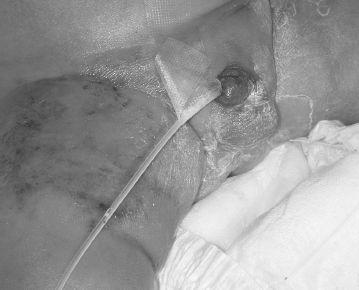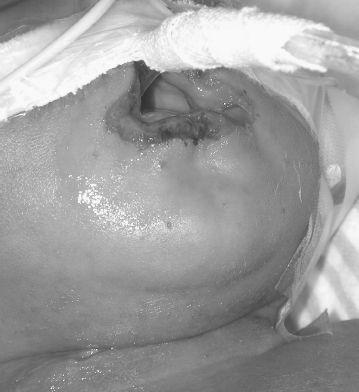Pediatric Examination and Board Review (37 page)
Read Pediatric Examination and Board Review Online
Authors: Robert Daum,Jason Canel

5.
(B)
Bathing in the management of atopic dermatitis has long been controversial. It is generally recognized that long soaks (>15 minutes) are detrimental to the barrier function of the skin, perhaps by compromising the lipid component of the stratum corneum. However, short baths (5 minutes) serve to hydrate the skin and are beneficial. The use of topical lubricants is also critical in the maintenance of a healthy skin barrier, and application of these agents immediately after bathing seems to improve their penetration and efficacy. Overuse of antibacterial agents may lead to drug resistance and so are not recommended for daily use.
6.
(C)
In most cases of atopic dermatitis, a single allergen is not the cause of the condition. Allergy testing in these individuals frequently finds sensitivity to many agents, only some or none of which may have any clinical relevance to the individual patient. Specific food allergies have been the hardest allergens to prove as the etiology of atopic dermatitis. Environmental agents such as dust, smoke, fragrance, and dander are more often positive.
7.
(B)
This patient’s presentation is classic for nickel contact allergy with an associated hypersensitivity reaction. These patients are often atopic or have an atopic family history. They constantly or recurrently have an active site of chronic dermatitis in the umbilical region, probably from contact with the metal buttons on many clothes, or the use of belts with metal buckles. The eruption on the extremities is probably secondary and the result of a more systemic sensitization to the local allergen. The eruption itself responds rather slowly to fairly potent topical corticosteroids, but of paramount importance is the counseling to avoid nickel metal contact. Attempting to keep a shirt tucked in as a barrier is usually inadequate. The use of nail polish lacquer on offending surfaces can be helpful. Oral antifungal medication has no benefit in this situation.
8.
(C)
Contact allergy to nickel metal is the most common contact allergy in the United States. This allergy likely plays a significant role in the dermatitis of many atopics. When there is a localized eruption in the periumbilical region, this allergen should be strongly suspected. Other sites commonly affected are earlobes, neck, and wrist. A fragrance mix and neomycin are also common allergens for contact allergy. Laundry detergents are often suspected, but if and when they are the true offenders it is probably because of the fragrance component. Peanut is a common systemic allergen.
9.
(B)
An acute onset of red scaly plaques could be attributed to pityriasis rosea or psoriasis. However, pityriasis rosea is rarely as red in color as psoriasis, and classically there is a first larger lesion about 2 weeks before the onset of the generalized rash. Additionally the lesions are typically distributed along skin tension lines, generating the classically described “fir tree” pattern. Guttate psoriasis-flares in pediatric patients are often in response to a strep pharyngitis. The lesions are small well-defined red plaques with the typical adherent scale of psoriasis. There may be other stigmata of psoriasis, such as a geographic tongue or nail changes. Scarlet fever is a widespread erythematous eruption of fine papules, without a plaque component. Mononucleosis rarely presents with a rash, and when it does it is the more nonspecific morbilliform eruption of a viral exanthem. Toxic shock syndrome presents with the patient in shock. The skin is confluently red, like a sunburn.
10.
(A)
It is important to look for the presence of streptococcal pharyngitis in the setting of guttate psoriasis. Treatment of the infection is often helpful in clearing the rash. A skin biopsy can be useful if the morphology of the rash makes the diagnosis less certain. A KOH prep is likely unnecessary, unless a diagnosis of tinea corporis is strongly suspected. An ANA is not necessary or helpful.
11.
(C)
Guttate psoriasis typically goes into remission with use of topical corticosteroids and occasionally the need for a limited course of phototherapy. Even careful sun exposure can be therapeutic, but patients must be cautioned not to get sunburned. These patients are at increased risk for the development of psoriasis vulgaris later in life. Pityriasis rosea generally takes 6-8 weeks to resolve and leaves postinflammatory changes for months. Scarlet fever fades in days, followed by significant desquamation. Limitations of physical activity are recommended in the setting of mononucleosis when splenomegaly is present.
12.
(A)
The presentation of dermatitis, irritability, and diarrhea is strongly suggestive of acrodermatitis enteropathica. A classic time for this condition to present is when the child is weaned from breast milk. One of the causes of the associated zincdeficient state seems to be a defect in absorption of zinc from the small intestine, perhaps because of a missing or malfunctioning transporter. The zinc in breast milk appears to be more bioavailable, and therefore the condition may be masked until this source of zinc is absent.
Figures 19-4
and
19-5
show examples of another child with zinc deficiency.

FIGURE 19-4.
See color plates.

FIGURE 19-5.
See color plates.
 S
S
UGGESTED
R
EADING
Hansen RC. Atopic dermatitis: taming “the itch that rashes.”
Contemp Pediatr.
2003;20(7):79-87.
Hogan PA. Papulosquamous disease. In: Schachner LA, Hansen RC. eds.
Pediatric Dermatology.
3rd ed. Edinburgh, United Kingdom: Mosby; 2003:643-656.
Silverberg NB, Licht J, Friedler S, et al. Nickel contact hypersensitivity in children.
Pediatr Dermatol.
2002;19(2):110-113.
CASE 20: AN 8-YEAR-OLD GIRL WITH HAIR LOSS
An 8-year-old white girl presents to your office reporting a 2-month history of hair loss and breakage, accompanied by itching and flaking in the scalp. Her mother notes that there have been rashes that have come and gone repeatedly on the skin of the arms and upper back as well. These rashes have improved with topical antifungal creams but continue to recur. Application of the antifungal cream to the scalp has not provided any relief. The child is otherwise healthy. No family members have been affected with similar rashes. The family has a dog and a cat at home. The child participates in a gymnastics school.
On physical examination, the child appears well and in no distress. On the crown of the scalp there is an area of hair loss about 1-2 cm in diameter, with hairs broken off at the scalp and scaling. There are several pustules in the region and a tender erythematous nodule. There are two palpable occipital lymph nodes that are nontender and nonfluctuant. On the upper back are ill-defined, somewhat faint erythematous plaques with minimal scale.
SELECT THE ONE BEST ANSWER
1.
The most appropriate treatment for this patient is
(A) mupirocin ointment twice daily
(B) clindamycin suspension 3 times a day
(C) cephalexin suspension 3 times a day
(D) ketoconazole shampoo daily
(E) griseofulvin suspension twice daily
2.
Duration of treatment should be
(A) 1 month
(B) 2 months
(C) 3 months
(D) 2 weeks
(E) until the hair is regrown
3.
The most suggestive risk factor for this condition in this patient is
(A) presence of a family cat and dog
(B) past use of hair permanents
(C) participation in gymnastics school
(D) the patient’s ethnic background
(E) wearing the hair in a ponytail daily
4.
Failure of past treatments has likely been a result of
(A) noncompliance
(B) organism resistance
(C) immunodeficiency
(D) endothrix infection
(E) failure to cut the hair short
5.
Tinea capitis infections are most common in
